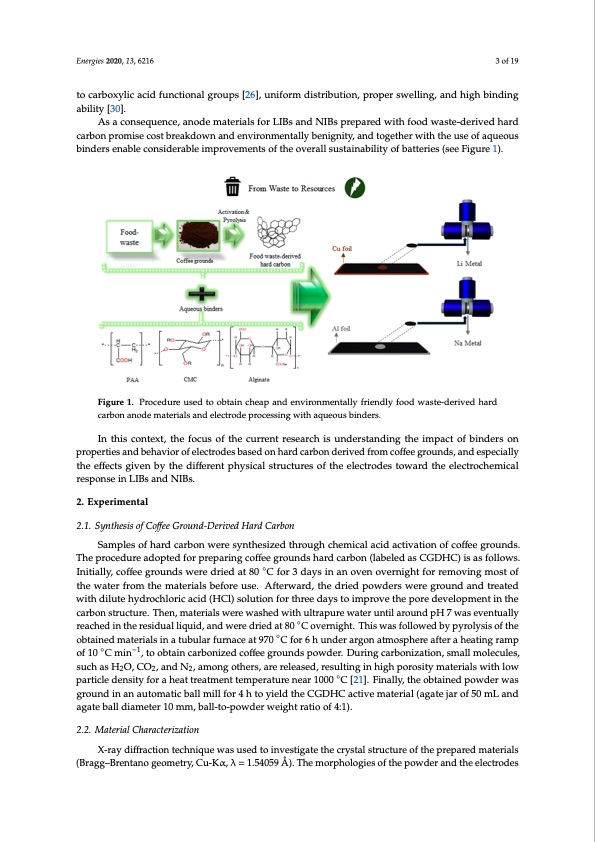
PDF Publication Title:
Text from PDF Page: 003
Eneerrgiieess2020,,133,,6x21F6OR PEER REVIEW 3 of 1290 collectors due to carboxylic acid functional groups [26], uniform distribution, proper swelling, and to carboxylic acid functional groups [26], uniform distribution, proper swelling, and high binding high binding ability [30]. ability [30]. As a consequence, anode materials for LIBs and NIBs prepared with food waste-derived hard As a consequence, anode materials for LIBs and NIBs prepared with food waste-derived hard carbon promise cost breakdown and environmentally benignity, and together with the use of carbon promise cost breakdown and environmentally benignity, and together with the use of aqueous aqueous binders enable considerable improvements of the overall sustainability of batteries (see binders enable considerable improvements of the overall sustainability of batteries (see Figure 1). Figure 1). Figure 1. Procedure used to obtain cheap and environmentally friendly food waste-derived hard Figure 1. Procedure used to obtain cheap and environmentally friendly food waste-derived hard carbon anode materials and electrode processing with aqueous binders. carbon anode materials and electrode processing with aqueous binders. In this context, the focus of the current research is understanding the impact of binders on In this context, the focus of the current research is understanding the impact of binders on properties and behavior of electrodes based on hard carbon derived from coffee grounds, and especially properties and behavior of electrodes based on hard carbon derived from coffee grounds, and the effects given by the different physical structures of the electrodes toward the electrochemical especially the effects given by the different physical structures of the electrodes toward the response in LIBs and NIBs. electrochemical response in LIBs and NIBs. 2. Experimental 2. Experimental 2.1. Synthesis of Coffee Ground-Derived Hard Carbon 2.1. Synthesis of Coffee Ground-Derived Hard Carbon Samples of hard carbon were synthesized through chemical acid activation of coffee grounds. The procedure adopted for preparing coffee grounds hard carbon (labeled as CGDHC) is as follows. Samples of hard carbon were synthesized through chemical acid activation of coffee grounds. Initially, coffee grounds were dried at 80 ◦C for 3 days in an oven overnight for removing most of The procedure adopted for preparing coffee grounds hard carbon (labeled as CGDHC) is as follows. the water from the materials before use. Afterward, the dried powders were ground and treated Initially, coffee grounds were dried at 80 °C for 3 days in an oven overnight for removing most of the with dilute hydrochloric acid (HCl) solution for three days to improve the pore development in the water from the materials before use. Afterward, the dried powders were ground and treated with carbon structure. Then, materials were washed with ultrapure water until around pH 7 was eventually dilute hydrochloric acid (HCl) solution for three days to improve the pore development in the carbon reached in the residual liquid, and were dried at 80 ◦C overnight. This was followed by pyrolysis of the structure. Then, materials were washed with ultrapure water until around pH 7 was eventually obtained materials in a tubular furnace at 970 ◦C for 6 h under argon atmosphere after a heating ramp reached in the residual liquid, and were dried at 80 °C overnight. This was followed by pyrolysis of of 10 ◦C min−1, to obtain carbonized coffee grounds powder. During carbonization, small molecules, the obtained materials in a tubular furnace at 970 °C for 6 h under argon atmosphere after a heating such as H O, CO , an−1d N , among others, are released, resulting in high porosity materials with low ramp of 120 °C m2 in , to2obtain carbonized coffee grounds powder. During carbonization, small particle density for a heat treatment temperature near 1000 ◦C [21]. Finally, the obtained powder was molecules, such as H2O, CO2, and N2, among others, are released, resulting in high porosity materials ground in an automatic ball mill for 4 h to yield the CGDHC active material (agate jar of 50 mL and with low particle density for a heat treatment temperature near 1000 °C [21]. Finally, the obtained agate ball diameter 10 mm, ball-to-powder weight ratio of 4:1). powder was ground in an automatic ball mill for 4 h to yield the CGDHC active material (agate jar of 50 mL and agate ball diameter 10 mm, ball-to-powder weight ratio of 4:1). 2.2. Material Characterization 2.2. MX-artaeyriadliCffrhacrtaicotnertiezachtinonique was used to investigate the crystal structure of the prepared materials (Bragg–Brentano geometry, Cu-Kα, λ = 1.54059 Å). The morphologies of the powder and the electrodes X-ray diffraction technique was used to investigate the crystal structure of the prepared materials (Bragg–Brentano geometry, Cu-Kα, λ = 1.54059 Å). The morphologies of the powder andPDF Image | Coffee Ground Sustainable Anodes Sodium-Ion Batteries

PDF Search Title:
Coffee Ground Sustainable Anodes Sodium-Ion BatteriesOriginal File Name Searched:
energies-13-06216.pdfDIY PDF Search: Google It | Yahoo | Bing
Salgenx Redox Flow Battery Technology: Salt water flow battery technology with low cost and great energy density that can be used for power storage and thermal storage. Let us de-risk your production using our license. Our aqueous flow battery is less cost than Tesla Megapack and available faster. Redox flow battery. No membrane needed like with Vanadium, or Bromine. Salgenx flow battery
| CONTACT TEL: 608-238-6001 Email: greg@salgenx.com | RSS | AMP |